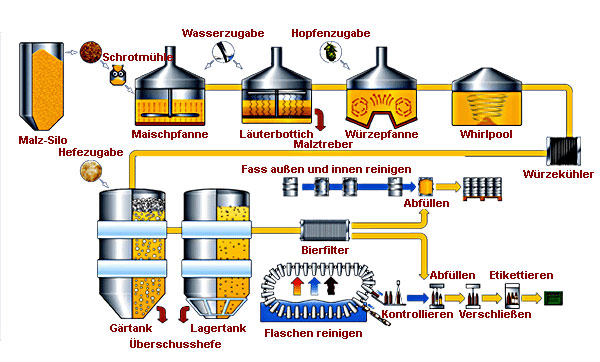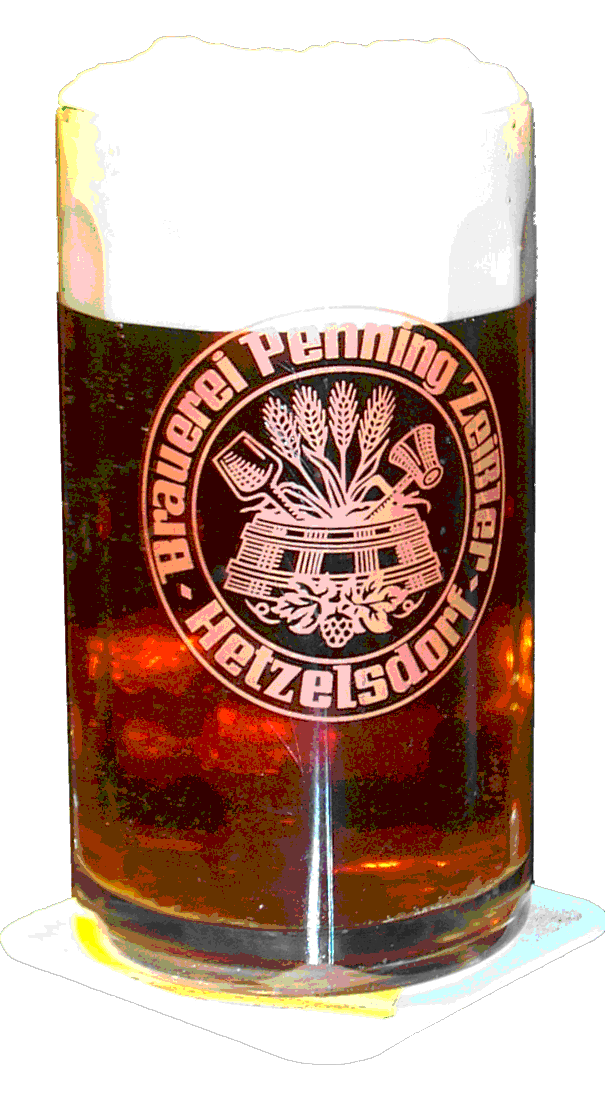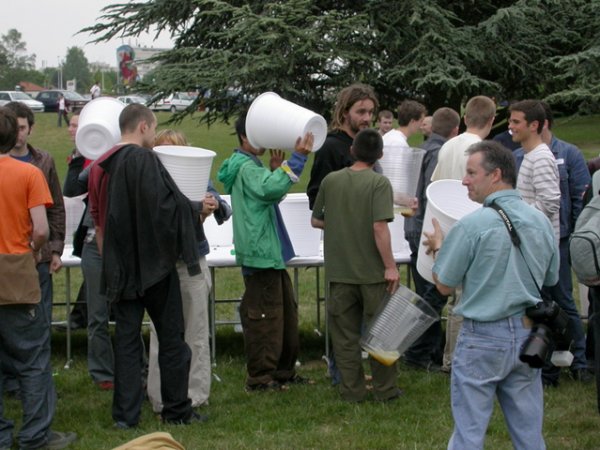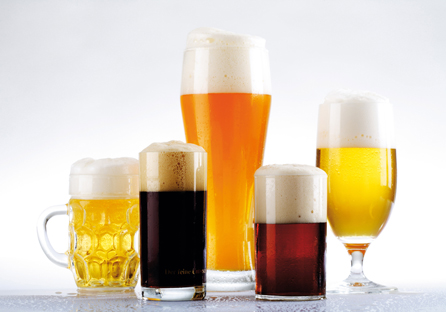
Welcome to my tribute to – Beer

Franconia has the highest density of beer breweries Truly unique is the variety of small breweries. On about 200 sq.km we find 74 brewers. It's just like it is with wine: Every brew tastes a bit different, depending on which brewer uses which kinds of hop and water. These aren't huge breweries. Sometimes the facilities are tiny, made just for the needs of its own pub. And that is why prices (calculated per half-liter beer) are so amazingly low.
The town of Aufseß is - according to the Guinness Book of
World Records - the original beer town. Measured by the numbers of residents
(1,400) and of breweries (4), the Guinness editors here found the world's
highest density of breweries. To live up to its reputation, the town has
recently opened the first "Brewery Hiking Trail" of the region. Over the course
of 13 kilometers all four breweries are visited by foot. Once this has been done
- which of course can be stretched over several days - each visitor receives a
certificate proving his commitment. For information and details on the route,
call the tourist information in Hollfeld: +49 (2974) 9800
By the way: There is a society called "Bierland Oberfranken", committed to
promote this "Beer Paradise" and its highest density of breweries around the
world.
More Information:
http://www.bierland-oberfranken.de
Reinheitsgebot
Germany is famous for the Reinheitsgebot (the German Beer Purity Law), a consumer law dating from 1516 that limits the ingredients of beer to water, barley, hops and yeast. It was officially repealed in 1987 following a ruling by the European Court of Justice, although even today few German breweries dare to produce beer that doesn't comply with it. Critics argue that it stifles variety and that it is not a problem to brew bad beer within the confines of the law, and vice-versa.

Brew your own Beer
If you want to make this really interesting experience of
brewing beer in Germany you find an expert under
www.ladidel.de
He is offering day or week-end courses, sometimes also in special locations.
You can also book for your whole group which will be a really funny experience.
Here some links of how to brew beer:
http://www.byo.com/
http://www.eartheasy.com/eat_homebrew.htm
The Brewing process
For the whole explanation go here:
Deutsch: Der
Brauprozess
English: The brewing process

Beer Breweries, Beer Events and Beer Cellars
Here you find a huge summary of Beer Cellars of the whole area including a lots of information like Beer of the Year, Making of and much more: http://www.bierkeller.de/
The Beer Breweries around Eelangen: http://www.bierkeller.de/index.php?regid=6
An English version of the Franconian Beer guide: http://www.franconiabeerguide.com/
The Beer Event Calender: http://www.bierkeller.de/index.php?text=bierkalender.html
The Beer Museum in Bamberg: http://www.brauereimuseum.de/usa.html
By the way – that’s my favorite beer: Hetzelsdorfer

Beers - Tours
There are a lot of really good booklets avaliable – for Bikes and Hikes.
Here some nice ones you find also in the Net
Brauereirunde mit dem Fahrrad in die Fränkische Schweiz: Tour #46629:
Bierwanderung um Aufseß: http://www.planetoutdoor.de/de/touren/detail.htm?tour=40556®ion=79
Biertour mit Fahrrad im Bierland Franken: http://www.saddelfest.de/wir_ueber_uns.htm
Fünf-Seidla-Steig: Eine genussvoller Brauereienwanderweg in der Fränkischen Schweiz
Bierquellen-Wanderweg: typische Erkundungstour zu fränkischen Kleinbrauereien
Waischenfelder Brauereiwanderung : Geführte, ganztägige Tour über 6 Brauereien über 16 km

Only one beer for the Road
Beer Links
Bier Welt 24 - alles über Bier
C64 the Beer PC Game as freeware download
Local Beer Types
In Franconia the standard German
offering of draught Export or Pils is usually replaced by one or more of the
traditional beers produced by local brewers:

1. Vollbier, can vary from light gold to almost black in colour. Malty
with a dry finish, it bears no resemblance to mass-produced lagers found in the
UK.
2. "Ungespundet" Lagerbier or Kellerbier, often brewed as an alternative
to vollbier. It is unfiltered and is often dispensed straight from the barrel
into stone mugs in Franconia’s beergardens (Keller). With a low CO2 content, it
is less malty and more hoppy than Vollbier.
3. Bockbier. Bockbier is a seasonal beer, similar to Vollbier, but
significantly stronger. The Bamberg Bockbiers appear around Mid-October and
lasts until Christmas.
4. Pils. Don't expect the local versions, fine as they are, to match the
characteristic dryish, hoppy flavour of North German and Czech pilseners.
5. Weissbier/Weizenbier (wheat beer), from Southern Bavaria is finding
its way into the portfolios of many breweries in Franconia. Top-fermented, it's
usually available in bottles rather than on draught, unfiltered and sedimented.
6. Rauchbier (smoke beer), is a speciality of the Bamberg area, its
characteristic taste is achieved by kilning the malt over a beechwood fire.
7. Märzen. The name derives from the month of March (März in German), the
last opportunity to brew beer before the hot summer weather set in and made the
brewing process risky. In Franconia the Festbiers, stronger than average beer
brewed for Christmas or other church festivals, are Märzen-type beers but the
term is also used for a stronger than average beer which is available at all
times e.g. Schlenkerla Rauchbier.
8. Schwarzbier (Black beer). Bamberg always had its own “little black
beer” in Klosterbräu’s Schwärzla, but "black" beer is becoming popular
nationally and others are now following the style. The darkest malts are used
but the beer is dark brown rather than black!
Other beers will be found which do not fall into the above categories; they
often represent attempts to resurrect beer styles of the nineteen twenties or
earlier, before paler coloured beers began to predominate. Names such as
Bauernbier (Farmers' beer), Landbier (Country beer), Braunbier (Brown beer) and
Alt Fränkisch (Old Franconian) are used to lend authenticity.